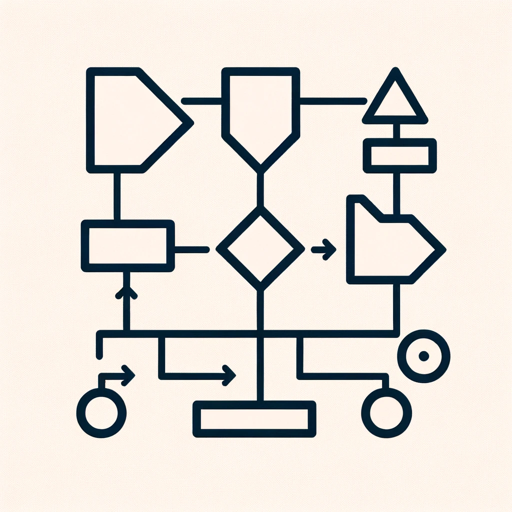Flowchart | Diagrama de flujo | خريطة تدفق | 流程图-AI-powered flowchart generator
Transform text into visual flowcharts with AI.
Click this button to start
Haz clic en este botón para comenzar
انقر على هذا الزر للبدء
点这个按钮开始
Related Tools
Load More
Flow Chart Genius
I create flow charts to explain connections.

Flowchart Generator
Expert in multilingual generation of sequence diagrams, Gantt charts, class diagrams, state diagrams, and flowcharts ^_^

Flowchart Maker 🌟
🔥 An expert in generating flowcharts 🌈. This GPT can make flowcharts directly in your chat 😄, without visiting other websites ✨. V2.0

Flowchart Maker
Converts algorithm to Mermaid flowchart URL

流程图大师 Flowchart Master
Guide users in creating flowcharts in a friendly and professional manner

Flow Diagram Producer
Specializes in precise flow diagrams.
20.0 / 5 (200 votes)
Introduction to Flowchart | Diagrama de flujo | خريطة تدفق | 流程图
Flowchart | Diagrama de flujo | خريطة تدفق | 流程图 is a versatile tool designed to create, manage, and visualize complex processes using flowcharts. It enables users to transform textual or code-based descriptions into graphical representations, making it easier to understand, communicate, and analyze processes. For instance, developers can use this tool to illustrate the flow of data in a software application, while business analysts might map out the steps in a workflow to identify inefficiencies.

Main Functions of Flowchart | Diagrama de flujo | خريطة تدفق | 流程图
Creating Flowcharts
Example
A developer creates a flowchart to represent the process of data loading, preprocessing, and analysis in a machine learning pipeline.
Scenario
By converting the steps of loading, exploring, and preprocessing data into a flowchart, the developer ensures that every team member understands the data preparation process, leading to better collaboration and fewer errors.
Managing Complex Processes
Example
A project manager uses a flowchart to map out the tasks, milestones, and dependencies in a project plan.
Scenario
This visual representation helps the team to see the project timeline clearly, understand task dependencies, and track progress, which aids in on-time project delivery.
Visualizing Algorithms
Example
An educator creates a flowchart to explain a sorting algorithm to students.
Scenario
Students can follow the flowchart to understand how the algorithm processes data step-by-step, enhancing their learning experience and grasp of complex concepts.
Ideal Users of Flowchart | Diagrama de flujo | خريطة تدفق | 流程图
Software Developers
Software developers benefit from using flowcharts to map out program logic, data flow, and system architecture. This helps in debugging, optimizing, and explaining code to team members and stakeholders.
Business Analysts
Business analysts use flowcharts to visualize business processes, identify bottlenecks, and design efficient workflows. This tool aids in communicating complex processes to non-technical stakeholders, facilitating better decision-making.

How to Use Flowchart | Diagrama de flujo | خريطة تدفق | 流程图
Step 1
Visit aichatonline.org for a free trial without login, also no need for ChatGPT Plus.
Step 2
Input your code or text that you want to convert into a flowchart.
Step 3
Use the provided tools to format and structure your input for optimal flowchart generation.
Step 4
Review the generated flowchart to ensure accuracy and completeness.
Step 5
Download or share the flowchart as needed for your projects or presentations.
Try other advanced and practical GPTs
Mid journey(ミッドジャーニー)プロンプトジェネレーター(日本語)
AI-Powered Prompt Generation for Creatives

超级写作(Super Writing )
Empowering Your Writing with AI

😊English Translation (Formal)
AI-powered precision for formal English.
Snapchat Ads Virtual Assistant
AI-powered insights for Snapchat Ads

のYouTube to Blog Wizard
Turn videos into engaging blogs with AI.

Maui Dev Assistant
AI-powered .NET MAUI Development Assistant

超级文本改写(去AI味儿~)
Transform AI Text into Human-Like Prose

Excel Data Analyst
Unlock Insights with AI-Powered Excel Analysis

Shiki
Unleash the Power of AI-Driven Insight

XYZ Nutritionist
AI-powered meal planning for optimal nutrition

ADA
Unveil the Past, Master the Present

Skills Finder
AI-powered career skill enhancer

- Academic Writing
- Project Management
- Software Development
- Business Process
- Educational Tutorials
Flowchart | Diagrama de flujo | خريطة تدفق | 流程图 Q&A
What is Flowchart | Diagrama de flujo | خريطة تدفق | 流程图?
It is a tool that helps users convert text or code into visual flowcharts for better understanding and presentation of processes.
How can I access this tool?
You can access it by visiting aichatonline.org for a free trial without the need to log in or subscribe to ChatGPT Plus.
What are common use cases for this tool?
Common use cases include academic writing, project management, software development, business process modeling, and educational tutorials.
Can I customize the generated flowcharts?
Yes, the tool allows you to format and structure your input to customize the appearance and content of the flowcharts.
Is there a limit to the number of flowcharts I can generate?
There is no specific limit mentioned for flowchart generation, but it is advisable to check the website for any usage policies or restrictions.